- Official EFT Tutorial
- Before You Begin
- PART I For Everyone: The EFT Tapping Basics
- Using EFT Tapping For Yourself
- Using EFT Tapping Professionally
- What is EFT? - Theory, Science and Uses
- How to do the EFT Tapping Basics - The Basic Recipe
- The EFT Constricted Breathing Technique
- Are You Satisfied With 20% of EFT's Tapping Possibilities?
- Strategies for Getting Started: Pain, Personal Peace, Physical Disease and More
- The Pros and Perils of EFT Tapping Scripts
- What can I expect from EFT Tapping?
- PART II For Everyone: Getting to the Roots of Your EFT Issues
- Intro to Part II
- Finding Aspects within the EFT Tapping Process
- Intro to Being Specific With EFT Tapping
- Testing Your EFT Tapping Work - The Triad
- Uncovering Specific Events - An Essential Concept Within the EFT Tapping Process
- The EFT Tell the Story Technique - The Workhorse Tapping Method
- What Should I Say During the EFT Tapping Process?
- The EFT Generalization Effect - A Big Step Toward Tapping Efficiency
- The EFT Personal Peace Procedure
- When to Use Global Approaches in the EFT Tapping Process
- The EFT Tapping Success Strategy
- PART III - Advanced: Additional Tapping Tools & Refinements
- Intro to Part III
- The EFT Movie Technique - A Useful Tapping Tool
- The EFT Tearless Trauma Technique
- Chasing the Pain - Deeper EFT Relief
- Cognitive Shifts - Belief Changes Within EFT
- Common EFT Challenges
- Emphasizing the Words - More Tapping Power When Needed
- Advanced Testing Techniques
- Testing The Tabletop
- Before You Move On To Deeper EFT Tapping Work...
- PART IV - Advanced: Tapping Deeper Into Emotional Issues
- PART V - Advanced: Polishing the Process & Expanding the Language
- EFT Bonus Articles
Table of Contents Help
The tabs on the right are shortcuts to where you have been:
- Previous Screen
- Previous Articles
- Previous Categories
- Start Page
- Hide Entire Menu
Swiping to the left will take you to the previous screen.
The folder icon indicates that more content is available. Click on the icon or the associated text, or swipe to the right to see the additional content.
Official EFT Tutorial
PART IV - Advanced: Tapping Deeper Into Emotional Issues
From the Writing on Our Walls to Table Tops
A Deeper Understanding of Emotional Issues
The Writing on our Walls was introduced in the last article to help you understand how emotional issues are formed and thus guide you toward Core Issues.
Just to review, here are a few common examples that might show up as the Writing on our Walls:
- Salesmen are pests.
- Rich people are greedy.
- Profits are bad.
- Diets don't work.
- Men don't cry.
- Nice girls don't do that.
- No pain, no gain.
- Good people work for free.
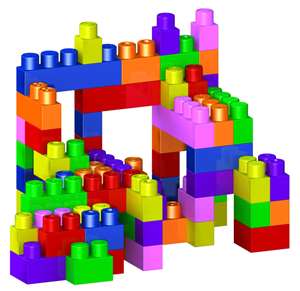
Adding a framework in which you
can organize all the pieces of
someone’s issue.
Whether you call them judgments, generalizations, interpretations, conclusions, decisions, beliefs or even truths, each of these examples represents someone’s understanding of how the world works.
In this article, we take the Writing on our Walls a few steps further by adding a framework in which you can organize all the pieces of someone’s issue. Putting this skill into practice will allow you to see the overall picture more clearly, choose more powerful directions, and develop the kind of EFT skill that clients will value.
The Central Idea for Finding Core Issues
To get started, we need to remember that…
The “truths” on people’s Walls were put there
by the Specific Events from their past.
That might sound familiar to you. Could it be that the “truths” are Tabletops and these Specific Events creating them are the Table Legs? If you already knew that, you get a gold star!
This is the central idea for finding core issues.
And it is easy enough when you have a fear of public speaking that was caused by one bad graduation speech. But it’s a little harder when it comes from a self esteem issue supported by a collection of childhood events.
You already know about Specific Events and how to address them. But as you may have discovered by now, not all issues can be collapsed by addressing the first Specific Event that comes up. Often you have to dig deeper, and without a map to guide you, the search for a particular Core Issue can be tedious. The framework we develop here will help you navigate through more complex issues, thereby allowing you to find the most effective Specific Events, and hence the most powerful results, much more quickly.
Identifying “Truths”
When your clients describe their issues to you, they have no idea that you are looking at the Writing on their Walls and trying to discover how their inner world is put together. Even if they did know, they probably couldn’t explain it to you along those lines, and they certainly couldn’t hand you a map. They have actually come to you for that service, so the better you are at working with their input, the better your sessions will be.
There are a lot of things a client could say when describing their issue to you, and not all of them represent “truths.” Most of it could be considered global, like a description or just general conversation about the problem … and it will usually take some effort on your part to uncover the real specifics, or something that might suggest a reason for the problem.
In general, once the client is finished with their description, the first thing we want to know is “Why?”…why does she feel that way, why is she in that situation, why does she continue to behave that way, what does that remind her of, what are the payoffs or penalties involved?
When you have explored deep enough to reveal the “Truths”, or Writing on her Walls, you can see what may be driving her behavior, or coloring her perception, and then you can start breaking that into Specific Events.
Here are some examples to help you with this idea.
General Conversation “Truths”
I don’t enjoy my job vs My coworkers don’t like me
My husband is critical vs Nobody appreciates me
I just can’t lose the weight vs I need food to relax
I can’t let go of my ex vs If I let go, then he wins
I take care of everyone but me vs I’m not valuable any other way
On the left side of each pair, you will see a typical client description of what she would like to change. Although these may seem like good places to start with EFT, they are missing some important features and may send you around in circles. On the other hand, the right side of each pair shows something that represents a foundational “Truth”, or the Writing on her Walls, which will provide much better tapping material.
Let’s take the first one for example. Your client says “I don’t enjoy my job”, but she doesn’t realize that there were some social circumstances affecting her experience. She just feels like the job isn’t fun anymore, maybe she no longer sees as much potential for promotion, or maybe she thinks a new field would be better. However, just for kicks, you ask her if she ever liked her job, and if there may have been any uncomfortable situations with her boss or coworkers to change that.

She remembers an office party
where two of the ladies excluded
her from a conversation.
She describes a lot of excitement at the beginning, and then remembers an office party where two of the ladies excluded her from a conversation. She felt rejected, buried her feelings in the name of professionalism and gradually stopped enjoying her job; but never understood why. The conclusion she made internally as a result of that experience is that her coworkers don’t like her, which represents a “Truth” in her mind. Further, it could easily be the reason why she isn’t happy at work, and it gives you a Specific Event to address with EFT.
Once you address that original upset, your client is free to clear the air with her coworkers, or simply make new friends, and the job becomes fun again. In this case, all it took were a few good questions to transform her entire experience at work … and it wasn’t even about the job.
Keep in mind, there is probably some experience with rejection earlier in her life that influenced her original reaction at the party. We call that a Core Issue, and if you ask a few more questions after dealing with the office party, you could probably get there pretty quickly. In fact, the more recent the event, the more likely it is reflecting off of much earlier issues. Let’s use the rest of the examples from the list above to illustrate that point.
My husband is critical: You could address a variety of individual events in which the husband was critical, but those will not be addressing the reason for your client’s reaction to it. If you discover that your client doesn’t believe that anyone appreciates her, you may find some Specific Events behind that with her family or childhood friends in which she decided that was true.
I just can’t lose the weight: Sure, there are specific examples of when your client tried to lose weight, but addressing those won’t necessarily get you to the cause of that problem. If you ask “why?” a few times, and discover that your client needs food to relax, you can start addressing whatever is causing him or her to be anxious or “unrelaxed”, or maybe there is a set of Specific Events in which food was connected to relaxation.
I can’t let go of my ex: When someone says they can’t do something that consciously they know they should, there may be a payoff or consequence involved. The client may not recognize it right away, but if you ask enough questions and discover something like “If I let go then he wins,” you can address the earlier Specific Events contributing to “I need to win.”
I take care of everyone but me: Again, if you ask enough questions to discover what’s behind that, and eventually get to a conclusion like “I’m not valuable any other way,” you can shift your focus to the Specific Events that led her to make that conclusion.
Each client will present a different set of experiences so you will have to develop your own list of helpful questions. However, these “truths”, beliefs, or Writing on the Walls can be identified as follows:
- Look for a conclusion, “Truth”, or general belief that someone has about themselves or the world (e.g. I’m not smart enough, women can’t be successful in business, etc)
- Look for a general fear (e.g. afraid to be thin, fear of rejection, fear of being alone, etc)
- Look for something that points directly to a collection of Specific Events (e.g. people don’t like me, I hate school, I can’t drive at night, etc)
These aren’t the only qualities that define the Writing on the Walls, but they will certainly get you off to a good start. The first two are really strong clues, but the third one is mandatory because...
...if you can’t see Specific Events behind someone’s issue,
then you need to keep digging.
You may notice that each of the choices on the right (in the example above) seems to point to a history of not-so-pleasant events, and because our main goal is to collapse Specific Events, each of these options is a potential gold mine.
Depending on your client, you may need to do some general tapping before you can get to the Writing on their Walls. Combining tapping with questions is an art that you will develop with experience. You will see a LOT of that art in the Art of Delivery videos, but be sure you realize that any preliminary tapping you do is simply a means to an end rather than a format for lasting results.
Further, even if an issue qualifies as Writing on the Walls, it may not be as influential for your client as other issues might be. In general, addressing “Truths” and events from earlier in life will make a bigger difference than those from the more recent history, so you may need to find several Specific Events before you get the results you want.
“Truths” to Tabletops

Now, let’s recall that these “truths” are what we use for Tabletops, and the contributing events are what we use as Table Legs. It is simple enough to imagine one issue as a Tabletop with several Specific Events supporting it, and you have already seen a diagram to that effect in the Specific Events article. But what about the circumstance when Tabletops are stacked on other Tabletops? That’s what happens when a more current problem has deeper roots. And keeping track of your progress in that case can be more complicated without some way to organize it.
With the Tabletop structure, you can identify the “truths” as well as the Specific Events during your sessions and see how they are related. This provides a much better idea of where you started and where you can go … kinda’ like having a map. This will improve your questions, give you a sense of direction, and help you discuss the results with your clients.
To better understand how a more complex issue would fit into the Tabletop structure, consider the example below.

If you ended up in the slowest line every time you went to the grocery store, you might eventually conclude that you “always end up in the slowest line.” At that point, you have constructed a Tabletop, supported by all the times it was true. From there, you will expect to end up in the slowest line, so you will look for evidence to support your conclusion, and continue to add “Legs” to support the Tabletop. Even when you didn’t end up in a slow line, you would consider that to be an exception to the rule and consider yourself “lucky this time,” which also supports the above conclusion. When addressing the issue of “I always end up in the slowest line” by simply removing the intensity of each Table Leg one by one, that conclusion, “Truth,” or Tabletop, eventually collapses.
However, the story gets a little more complicated in real life. Let’s say that your mother had a way of letting you know you were “doing it wrong” and, no matter what you tried, you always walked away feeling like you “did it wrong.” After dozens of Specific Events with the same message, you would eventually conclude that you will “always do it wrong.” Then, when you’re in junior high and you get 82% on your vocabulary test, you will walk away saying “look at that, I did it wrong” … and your mother may even reinforce that for you when you get home.
To carry this further, after you have had a few failed relationships you might say, “I choose the wrong partners”; when you imagine a promotion at work you might say, “I make too many mistakes to keep that job”; and when you go to the grocery store, you may say “I always end up in the wrong line.” These are all variations of the original conclusion “I always do it wrong,” and although you will probably keep hoping for your “luck to change,” the Writing on your Walls will help you to continue producing the same outcome in your life.
The original conclusion, based on experiences with your mother, represents a Tabletop within the Writing on your Walls, and we’ll call it the “I always do it wrong” Tabletop. See the diagram below.
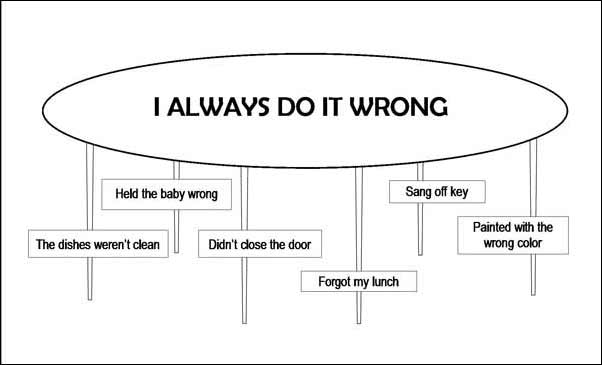
The individual experiences supporting that Tabletop are listed below.
- When my mother scolded me for putting a dirty dish in the cupboard.
- When I held my baby sister for the first time and didn't support her head.
- When I came in the front door and didn’t close it all the way.
- When I forgot my lunch at home and my mother was late to work because she had to bring it to me.
- When I sang out loud for the first time and my father said I was off key.
- When I painted a picture and my teacher thought the blue should have been lighter.
They are called Table Legs because, without those experiences, the conclusion or Tabletop called “I always do it wrong” wouldn’t exist.
Because this Tabletop was created earlier in life, it sits deeper in your system than some of the others, and probably directly underneath the more recent similar tabletops of “I choose the wrong partners,” “I can’t have a better job” and “I always end up in the wrong line.” See the diagram below.
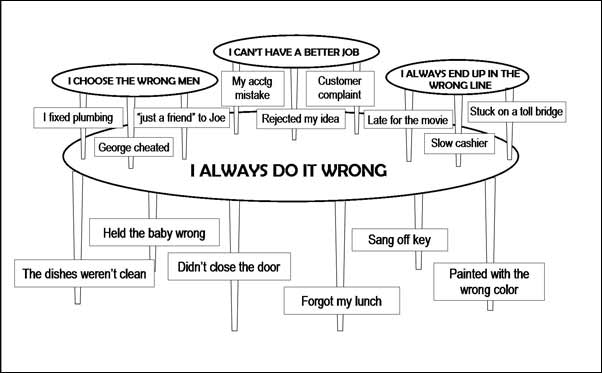
These more recent tabletops have their own Legs, representing related experiences with the same outcome. However, because they were created on the foundation of “I always do it wrong” we would say that they sit on top of the original, deeper Tabletop and cannot be completely collapsed until the earlier one is addressed.
In the diagram below, you will see that if you collapse all the legs under the more recent Tabletops, they would simply land right on top of the earlier Tabletop. Further, as long as the deeper issue is still intact, you would continue to erect new legs for the smaller tables, or build a few new Tabletops in the name of “I always do it wrong,” using the experiences to come. That’s because you still expect to “do it wrong,” so your system will find ways to make that true. This big, deeper tabletop is called a Core Issue, and ultimately, those are the ones we want to collapse.
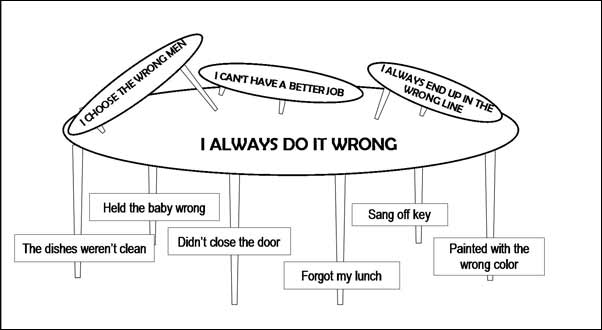
Now, look at the diagram below and you can see how collapsing the Core Issue will destroy the foundation for all of the issues developed on top of it. By addressing these foundational issues, you will have the emotional freedom to choose an entirely new perspective, simply because you’re no longer limited by that one belief, or “Truth.” Once the perception “I always do it wrong” is addressed, you may be able to see that your mother was trying to help you be a better person, and although you would have preferred that she do it in a different way, her efforts may no longer feel like criticism. From there, you have the opportunity to see that the grocery lines, failed relationships and limited career potential might be just fears rather than realities. Thus your system will no longer need to choose the “doing it wrong” scenarios ... and that’s how enormous paradigm shifts happen with EFT.
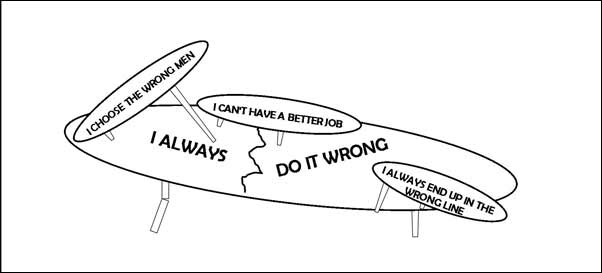
Collapsing Core Issues is not always easy or quick, but it is the “holy grail” of EFT sessions, and is the ultimate goal of any great EFT Practitioner.
Overall Picture
As you will discover, each client has his/her own fascinating puzzle of issues and events held together by beliefs, justifications, and patterns. As each client is different, each process will be different, so you will need to use your own judgment about which direction to take and where to start and end your sessions.
We do realize that EFT sessions can’t all be as structured as the examples, and they won’t all fit easily into a Tabletop diagram. Imagine that one client has a fear of heights, issues with commitment, occasional insomnia and an overall lack of confidence. Can you imagine how many stacks of Tabletops might be present in their emotional makeup? Actually, in the grand scheme of things, that’s a fairly normal person. When you start dealing with more severe cases, the complexity can become overwhelming if you don’t have some way to organize it all. In your EFT practice, you will find that it is best to narrow your focus to one issue or one “stack” of Tabletops whenever possible.
Sometimes we get caught in a daisy chain that lasts half an hour and have to follow the intensity, but at some point, it is valuable to stop and collect your thoughts, evaluate where you have been, what has actually collapsed, and what is still “on the Table” to address.
A “daisy chain” is how tapping on one event can reveal another, then another, and another, etc. In a daisy chain, you may have collapsed three issues under one Tabletop, one Core Issue below that, and then shifted to a handful of events under another Tabletop. If you send your client out the door without evaluating the progress, neither you nor your client will know what to expect from the results. It’s much more professional to gather your thoughts, organize the pieces of the issues and formulate a game plan that includes client homework and material for the next session that will be consistent with the work you have already accomplished together.
Testing Tabletops
When you test your Tabletop, you are definitely trying to find out if there are any more aspects or Specific Events still holding it up. However, you are also trying to evaluate the status of that original “Truth,” because that was the issue you were hired to address.
It’s like a mechanic who is hired to find out why the engine won’t start in your car. He may fix the alternator, a dirty spark plug and something in the ignition, but he doesn’t give the car back until the engine starts.
You can use any of the methods in the Testing article that fit the details of the issue at hand. The "Say This..." method can be particularly useful in this regard. Remember that a Tabletop is a global issue, so the testing is more complicated, and may not be conclusive until the client has proven the result in a variety of real situations outside your office.
Using Caution with Challenging Core Issues

Be prepared that once you reach a Core Issue, the events often become more intense, and the issues can be more difficult for people to let go. People build their entire lives on the conclusions they make as children, so addressing a Core Issue can be like taking their Legs out from under them.
Many people have grown into new lives and are ready to be set free from a past that no longer supports them. Others are still very attached to their early “Truths,” their view of their parents, or their other protective layers, so in this case you might really have your hands full. Either way, when dealing with Core Issues, all of your EFT skills will be tested, along with those for rapport, compassion, communication and common sense, so please don’t go there unprepared.
At this point, it is appropriate to remind you that using EFT professionally carries some risk of exposing unexpected traumatic memories for your client. Be sure you completely understand the material on Taking the Edge Off and Meltdowns and pay attention to the avenues you choose with clients. If you suspect someone has an issue that you aren’t qualified to address, be prepared with referrals to qualified mental health professionals and know the procedures for a meltdown or abreaction just in case.
No matter how good you are with the EFT mechanics, you will also need to understand the psychology of your clients. For most people, that will come with experience, but if you have not been trained in psychology or a related therapy field, your skill in this area might develop more slowly. In that case, you might want to consider getting more trauma training and/or more clinical supervision from a colleague who has the skills you currently lack.
© Gary and Tina Craig
All Rights Reserved
Please note: This Tutorial, while useful, was replaced in 2014 by my newest advancement, Optimal EFT. More efficient. More powerful. Full explanation given in my free, easy-to-read e-book, The Unseen Therapist.






